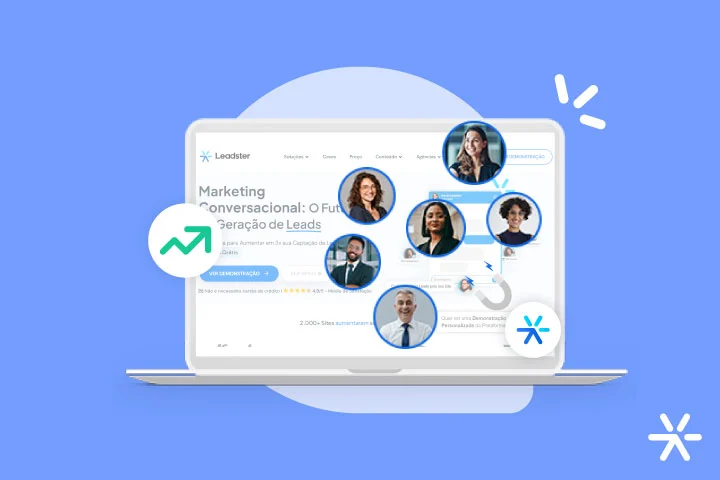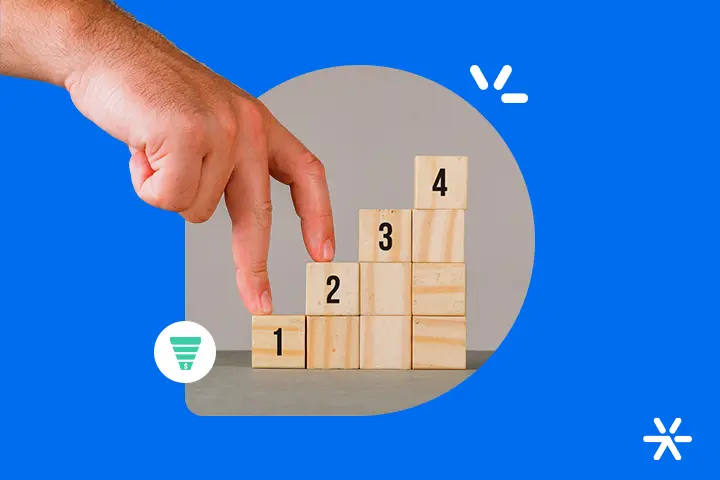9 Tips to Increase Lead and Sales Conversion Rates
Are Your Strategies Bringing More Traffic to Your Pages? That’s Great!
But despite that, have you noticed that your conversion rate is low?
Converting visitors into leads, let alone into customers, is a challenge. It takes significant effort in every conversion opportunity to consistently achieve better results.
With that in mind, we’ve put together 9 essential tips that you can apply right now to increase your lead and sales conversion rates.
Let’s get started! But first, let’s understand what a good conversion rate is.
Check it out 👇
What Is a Good Conversion Rate?
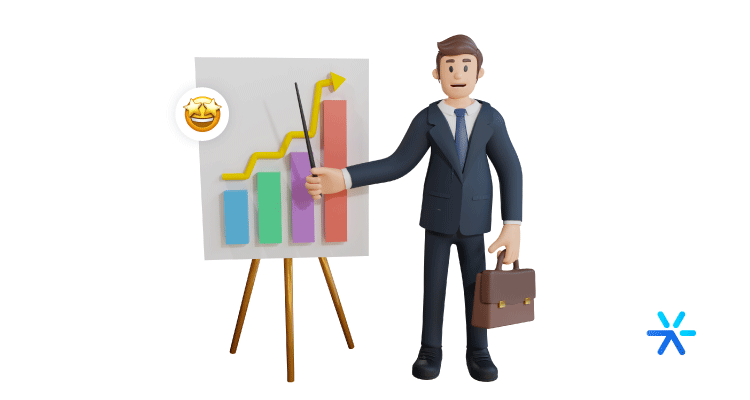
To determine whether your conversion rate is good or not, you need to analyze the numbers in your industry.
For instance, if the conversion rate of visitors to leads in the B2B segment is 5% (a hypothetical figure), but your rate is 2%, it’s time to invest in new strategies.
A great resource for this analysis is the Webshoppers Magazine by NielsenIQ, which provides semi-annual analyses of sales conversion rates across various e-commerce sectors.
For lead conversion, we’ve already published a detailed study showing the breakdown by different segments.
By analyzing the conversion rate, you can measure the performance of your marketing actions.
Generally, a good conversion rate is one that is consistently growing.
It’s also worth noting that we must always differentiate between lead conversion rates and sales conversion rates, as the numbers are not the same.
Let’s understand more below:
What Is the Ideal Sales Conversion Rate?
Throughout the article, I mentioned that conversion rates are not all the same, remember?
Earlier, we discussed the process of converting visitors into leads; now we are addressing sales conversion.
To help us determine the ideal sales conversion rate, let’s look at some data from the American company Compass.
In its study, the company found that the average sales conversion rate in e-commerce is 1.33%, while the top performers have rates around 3.6%.
Yes, these are low numbers, and that’s why they are challenging. Let’s now understand why your conversion rate might be low.
Why Is Your Conversion Rate Low?
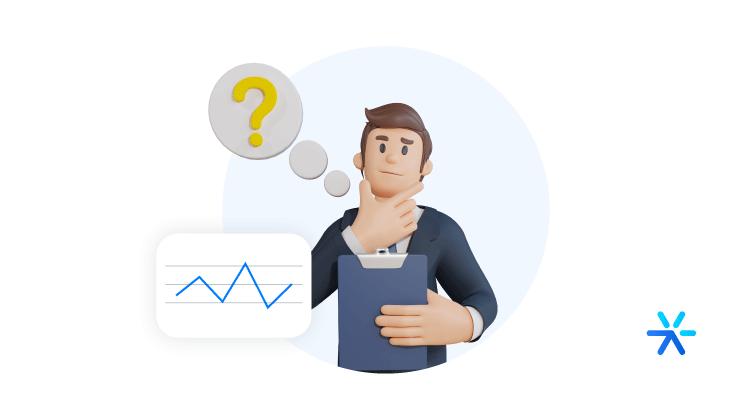
Several factors can contribute to a low sales conversion rate on your site.
We’ve selected the main ones, along with solutions to increase your page’s conversion rate.
You’re Not Considering the Customer Journey
The marketing and sales funnel is a strategic tool that guides your efforts until the close of a sale or contract.
If you don’t consider the stage the visitor is in along this funnel, it will be much harder to align your verbal and visual communication, which is responsible for capturing the user’s attention and increasing conversion chances.
If this is one of the reasons for your low conversion rates, seek to understand your audience’s needs and interests better.
Remember that the sales funnel is a framework, but your customer can enter it at any stage. They might arrive at the top, identifying their needs, or they might already be seeking a quote.
Here’s a crucial tip to increase conversion: replace static forms with more interactive tools like marketing and sales chatbots.
Analyze the content, offers, and presentation of these elements on your site with the sales funnel in mind!
You might also be interested in: Is Your Marketing Funnel “Congested”? Discover the Most Common Problems
The Site Is Not Optimized for Mobile
As we identified in the Lead Generation Panorama developed by Leadster, mobile already accounts for the majority of traffic to Brazilian websites, with 64.45% of visitors – compared to 35.55% from desktops.
However, when analyzing conversion rates for this device type, we notice that they are, on average, lower than desktop conversions.
This occurs because many companies still fail to optimize their websites for mobile, losing the opportunity to provide the best experience for users who access the pages via mobile devices.
The Value Proposition Is Not Evident
A good value proposition should clearly convey relevance, benefits, and differentiation.
Thus, your brand establishes a strong market position and generates engagement with the audiences it seeks to reach.
It’s the perceived value proposition that determines whether or not the consumer will take the next step – the proposed conversion.
If the value proposition isn’t clear on the site or on conversion pages, the benefits and differentiators of the product or service can get lost, along with the visitor’s interest and conversion.
The CTA Doesn’t Convince the User to Take Action
Testing and improving CTAs is another way to increase your site’s conversion.
A Call to Action (CTA) is a prompt that encourages a specific action. If your goal is for the reader or visitor to take an action after interacting with your company’s content, you need to make that clear, right?
A CTA makes that action a priority by highlighting it and encouraging the visitor to continue engaging with your brand, whether by clicking on a link to another article, providing an email address, or signing up for a free trial.
There are many options for maintaining the visitor’s attention on your pages or moving them to the next stage in the conversion funnel.
A good CTA should consider the persona, the stage of the sales funnel, the level of knowledge regarding the conversion, and have a clear objective.
The Copy Isn’t Persuasive
Copywriting is a writing technique focused on persuasion and conversion.
By applying persuasive texts, the target audience is encouraged to take a specific action – in this case, to convert as expected.
More than just creating persuasive content, the copy must be clear, objective, creative, and capable of effectively communicating with the persona at their particular stage in the buying journey.
There Are Too Many Barriers to Conversion
Every element on a page contributes to the user experience and can either facilitate or hinder conversion.
If these elements complicate rather than simplify navigation and user experience, they become barriers to the desired action.
For instance, a form with too many questions can be a barrier to conversion.
According to HubSpot, forms with more than three questions tend to have lower conversion rates.
How to Optimize Your Site’s Conversion?
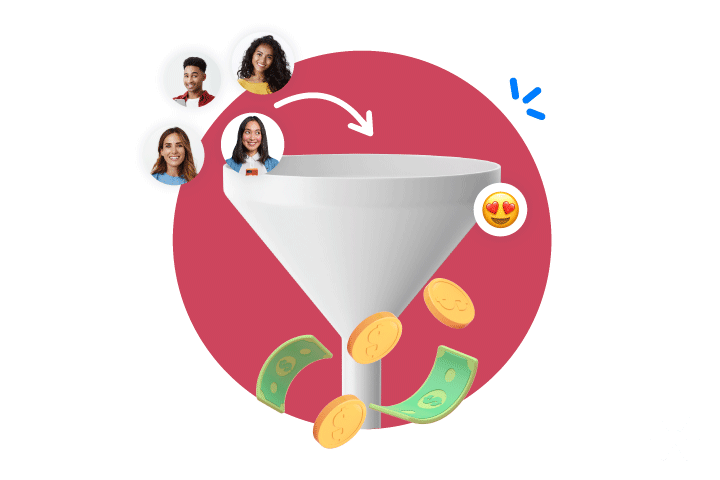
If you want to increase your site’s conversion, you must invest in improvements in areas such as Search Engine Optimization (SEO) and Conversion Rate Optimization (CRO).
It’s also necessary to tailor the content to the personas and sales funnel stages, as well as review page structure to enhance user experience, copywriting, and site layout – eliminating barriers and encouraging conversion.
Below, you can check out 9 practical tips to increase your lead and sales conversion rates.
Practical Tips to Increase Lead and Sales Conversion Rates
1. Organize Your Data
Optimization can only be done effectively if you have data to guide decision-making.
You might know your site or landing page conversion rates – and maybe that’s why you’re here – but are you analyzing the complete scenario?
There are some key pieces of data to monitor closely:
- Where Do Your Website Visitors Come From? (Google Ads, Organic, Facebook Ads, etc.)
- Which of these channels generate more or fewer conversions?
- Which specific paid media campaigns generate the most traffic and conversions?
- Which of your pages have the best and worst conversion rates? What are the differences between them?
- Where are the biggest conversion gaps within the sales funnel stages?
- How many of your leads have been impacted by a nurturing strategy?
You can access this data through platforms that already provide a simplified dashboard or through methods of tracking and measuring campaign performance, such as cookies, UTM codes, and pixels.
2. Improve Site Speed
The technical aspect also matters. Few users have the patience to wait for a slow site to convert.
In fact, the first five seconds of page loading have the most impact on conversion rates.
After this period, every additional second reduces your conversion rate by an average of 4.42% (Source: Portent, 2019).
Loading speed is also one of the main factors for a site to rank well on Google.
You can check your site’s speed — and get tips on how to improve it — using the Google PageSpeed Insights tool.
Some basic changes, like compressing site images, can be easily implemented.
However, you may need the help of a developer to apply more advanced improvements.
Read more: 5 Reasons to Improve Your Site Speed Right Now
3. Optimize Your Site for Mobile
In addition to site speed, adaptability for different screens is also crucial when analyzing conversion rates.
Websites and landing pages that are not responsive lose users who access them via mobile devices — and these users already account for the majority of website visits.
In the US alone, 79% of smartphone users made at least one online purchase using a mobile device in the last six months.
4. Run (Many!) Tests
To optimize your conversion rates, you should also explore testing, not just on the pages themselves but also on the materials leading to them, such as ads, emails, references, etc.
A/B tests should be utilized to present two versions of the same material with small modifications in text or visuals.
Both versions are shown to the audience during a test period, and the one with the best performance becomes the standard.
This strategy helps to understand what is better received by the audience.
You can also analyze the conversion rates of your tests to invest in the version with the most satisfactory results.
5. Personalize Your CTAs
A Call-to-Action (CTA) is a prompt to take action.
It appears on different types of pages and materials, guiding the visitor toward the action your company wants them to take.
Personalizing the CTA according to the user profile and the stage they are in within the buying journey can significantly increase the conversion rate, as attention is captured in a differentiated manner, and the action stimulus is also personalized.
For example, on a legal consultancy website:
According to HubSpot, the world’s largest marketing automation platform, personalized CTAs have up to 202% better performance and results than those without personalization.
6. Capture Visitor Attention Quickly
You have only 3 seconds to capture your visitor’s attention. How are you utilizing this extremely short window?
Your conversion page — whether it’s a landing page or your main website — must align with what the visitor expects.
More than that, it needs to contain textual and visual elements that align with the stage they are in within the buying journey.
Therefore, in addition to optimizing your site’s speed, it’s essential that your value proposition (the benefit your product or service provides to the client) is evident as soon as the visitor lands on the page.
For instance:
Notice how the highlighted information is likely the reason the visitor was led to this site (Increasing Customer Satisfaction).
Meanwhile, the actual product being sold (a Contact Center) is presented as a secondary element.
This is a good practice to attract visitor attention quickly, delivering the value they expect to find.
7. Add Social Proof on Conversion Pages
Social proof is a persuasive tool when convincing a potential customer to complete a purchase or contract with your company.
By featuring a testimonial or validation from someone who is already familiar with the brand and has benefited from the offered solution, credibility increases, and the decision-making process is facilitated.
According to German research firm Statista, 30% of consumers agree that social proof significantly impacts trust in a product or brand during the purchase decision.
8. Reduce the Number of Form Fields
People will only fill out a form and wait for a response if they are convinced that the offered benefit (whether it’s a video, an e-book, a demo, etc.) is truly worthwhile.
If you’ve worked with lead conversion through static forms, you know how challenging it can be to achieve significant conversion rates when asking for more specific information about the visitor.
And as a visitor yourself, you may have abandoned a form upon encountering a never-ending list of questions.
Thus, after defining your qualification criteria, remove all non-essential information from the forms — especially in top-of-the-funnel forms.
Put yourself in the visitor’s shoes: “Is it worth giving my CPF and phone number in exchange for a simple e-book? Am I open to receiving a sales call after conversion?”
If the answer is no, you already know: it might be time to reduce the form’s complexity.
9. Replace Forms with a Chatbot
Virtual assistants, or chatbots, are the best alternative to static forms and are gaining traction as they offer better conversion rates and a more interactive, dynamic user experience.
These tools engage each consumer in a personalized manner, according to their navigation context, increasing engagement.
According to a survey by Twilio, 90% of consumers want to communicate with companies via messaging.
Addressing this market demand, a chatbot can help you gather more information about the lead in a natural conversation, accelerating the qualification process and increasing conversions.
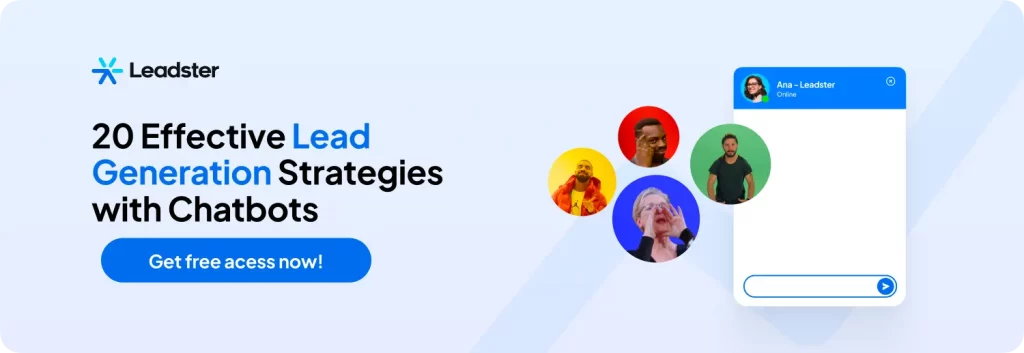
What Is CRO and How to Use It on Your Site?
CRO (Conversion Rate Optimization) refers to the set of strategies used to optimize a site’s conversion rates.
Optimizing your conversion rates can lead to several positive outcomes, such as:
- Increasing the number of qualified leads;
- Boosting revenue;
- Reducing lead acquisition costs;
- Extracting more value from current clients and leads;
- Closing more sales;
- And more.
If you want to improve your brand’s conversion rates, you should focus on CRO, which proposes adjusting and enhancing your site’s existing structure to increase conversion rates and results.
Where to Implement CRO?
If you want more conversions and can use CRO to optimize your existing pages, which ones should you prioritize?
You have three options:
- Pages that already perform well but could do even better;
- Pages that are not performing well but would be easy to optimize;
- Pages that are more challenging to optimize but are likely to generate results after optimization.
To help you decide, use the P.I.E. Framework:
Lastly, always remember to apply CRO on critical conversion pages, such as:
- Home page;
- Category pages;
- Product pages;
- Pricing pages;
- Blog;
- Landing pages.
Best CRO Strategies
Some effective CRO practices you should consider:
- Create personalized CTAs for all blog posts;
- Develop nurturing flows and feed them with your content;
- Conduct tests on your lead capture pages;
- Help leads become qualified leads with free trials and downloadable content;
- Create automated workflows to assist your team;
- Add targeted messages to high-conversion pages;
- Optimize high-performing blog posts;
- Use retargeting to re-engage site visitors.
How to Use the R.E.A.D.Y Framework to Increase Your Conversion Rate
The R.E.A.D.Y framework lists the 5 main dimensions that impact a conversion rate optimization (CRO) strategy:
- (R) Relevant: relevance
- (E) Engaging: engagement
- (A) Authoritative: authority
- (D) Directional: direction
- (Y) Yield Optimal: optimal performance
Although it is not the only structure available for executing a CRO strategy, the R.E.A.D.Y framework provides a very interesting perspective on aspects that impact websites and landing pages, whether in the B2B or B2C market.
For each of the 5 dimensions, the framework unfolds into 5 additional factors that help structure the optimization work.
Check out each one below:
Relevance
A relevant site is one that meets the visitor’s expectations. To optimize conversion, your site should:
- Deliver on the promises made to the visitor at the time of the click or conversion;
- Maintain context, following the same line of thought from the ad to the landing page;
- Be visually coherent, with ads and page layouts that communicate with each other;
- Generate identification and empathy with the audience, speaking their language;
- Be timely and always up-to-date.
Engagement
This dimension of CRO work refers to how well your message resonates with your target audience. To achieve this, you need to:
- Offer a value proposition that aligns with the visitor’s expectations;
- Create emotional appeal through storytelling, design, color theory, etc.;
- Present logical and rational arguments to persuade the visitor;
- Adopt an affective design, combining aesthetics and functionality;
- Be authentic, creative, and distinctive.
Authority
Authority is one of the most important triggers when it comes to online conversions. The best sites should:
- Provide guarantees and credibility signals;
- Be precise and convincing through details, images, demonstrations, etc.;
- Adopt and comply with privacy policies and usage rules;
- Include customer testimonials as social proof;
- Have consistent branding.
Direction
Conversion is essentially a direction — a path you want the visitor to follow. To optimize this aspect, it is necessary to:
- Have a clear and prominent CTA on the page;
- Facilitate decision-making by providing the right amount of information;
- Reduce elements that could distract the visitor from the conversion goal;
- Offer incentives, such as compelling storytelling or mental triggers, to guide navigation;
- Create a natural progression on the page, leading the visitor through micro-conversions.
Performance
Last but not least is the most technical dimension of conversion optimization. To improve your results, make sure to:
- Develop relevant hypotheses to test conversion elements;
- Perform A/B testing regularly and maintain a culture of experimentation;
- Monitor metrics and results closely;
- Work on an SEO strategy, including keywords, link building, etc.;
- Review the framework regularly to find new optimization opportunities.
How many checks ✅ did your site score on the R.E.A.D.Y framework?
How to Use SEO to Increase Your Conversions

With SEO (Search Engine Optimization), you will be optimizing content for websites, blogs, and pages.
However, unlike CRO, you will consider factors relevant to search engines, such as Google.
By implementing this strategy, you will be competing for better positioning in search engine queries, thereby driving more organic traffic to your site.
Let’s understand which SEO techniques you can apply to increase your conversion rate:
Keyword Research for Product and Category Pages
Yes, even the words you use in your articles matter. 🤓
You will need to conduct thorough keyword research to discover what and how users are searching for specific terms related to your segment and area of expertise.
This way, you can create content for your site, product descriptions, category pages, and other areas according to what people are searching for.
To assist you in this journey, invest in SEO tools like SEMRush, Google Keyword Planner, and Ubersuggest.
We’ve discussed this in more detail in our article on keyword research.
Content Marketing Focused on Long-Tail Keywords
Content marketing is responsible for planning and creating content for your site — usually for blogs and product pages.
It is used alongside SEO to increase your conversions. To do this, you will need to invest in long-tail keywords — those that are longer and more specific.
For example, many people search for words like mattress, mattress store, single mattress, double mattress, and you can be sure there are hundreds of results for these searches, making it difficult to stand out.
This is where long-tail keywords come into play.
Instead of creating content about “mattress,” try:
- Mattresses with the best prices;
- Mattress for back pain;
- Best mattresses on the market;
- Mattress store in NY.
Differences Between On-Page SEO and Off-Page SEO
Working on SEO means paying attention to both what happens on your page and what happens outside of it.
To clarify, here are the two types of SEO:
- On-Page SEO – Includes all practices carried out on the company’s website or blog. These changes only occur on these channels and involve specific adjustments for search engine algorithms. Examples: titles, subtitles, meta descriptions, and URLs.
- Off-Page SEO – Involves practices carried out externally — outside the site. These actions primarily aim to increase the site’s recognition and relevance. Examples: partnerships, content production, comments, backlinks, and social media.
FAQs About Conversion Rate

What is a Conversion Rate?
The conversion rate is the percentage between the number of visitors to your conversion pages and the number of people who actually complete the conversion.
By conversion, we mean the measurable action you expect from your visitor.
It could be filling out a form, initiating your online chat, signing up to receive a discount coupon, completing a purchase, taking a free trial, upgrading a plan, or other actions.
The conversion rate can also be calculated between other stages of the funnel, such as the conversion rate between qualified leads and sales, between visitors and SQLs, etc.
How to Calculate Your Website’s Conversion Rate?
To calculate the conversion rates of your pages, you need to have some key numbers on hand, such as the total number of visitors, leads, opportunities, and sales.
The conversion rate will always be the ratio between two stages of the user’s journey in the sales funnel.
Thus, the conversion rate calculation can be done as follows:
For example, let’s say you want to know the conversion rate of a Landing Page over the last month.
In this case, the calculation would be:
Why Optimize Your Site’s Conversion Rate?
The conversion rate is one of the most important metrics for those investing in digital marketing.
This is because it indicates the success of campaigns and whether the investment is generating the desired outcomes.
Think about your campaigns: they have an objective, which is to lead the user to a specific action, whether it’s a registration, downloading a material, or purchasing a product.
Therefore, the conversion rate is the metric that shows whether that action was completed, i.e., it’s directly related to the success achieved by the campaign, material, or page.
What Is the Relationship Between Conversion Rate and ROI?
ROI stands for Return on Investment.
ROI is primarily tracked when we talk about marketing investments, related to the costs and outcomes of campaigns, actions, and new marketing strategies implemented.
ROI calculates how much money the company gains or loses from the investments made.
And the conversion rate calculates the success of campaigns, actions, and articles.
Therefore, the two are related because the better the conversion rate, generally, the better the ROI.
Discover How Leadster Can Triple Your Site’s Conversion
With personalized service, even for simple interactions, a lead is more likely to convert after resolving their doubts and establishing a connection with the brand.
Conversational Marketing is one of the most dynamic and modern ways to generate qualified leads for your company.
At Leadster, we have developed a proprietary methodology, combining five years of chatbot expertise with the best practices in online conversion optimization.
Our tool optimizes website conversion rates by enabling personalization, testing, quick visitor engagement, and replacing static forms.
Want to implement this strategy for your brand?
Learn more about our tool by exploring a personalized demo tailored to your needs right now!





